- Solar advice hub
- Batteries
- Are solar batteries worth it?
Are solar batteries worth it?
Here's how solar battery storage works, how to pick the best type for your home, how much it can save you, and whether it's worth it.


Why you can trust our content
We know that the solar industry is full of misinformation, but we only use reliable sources, including:
- Our experienced solar experts, installers and system designers
- Our own database of solar & battery system designs
- Authoritative bodies like MCS and the UK government



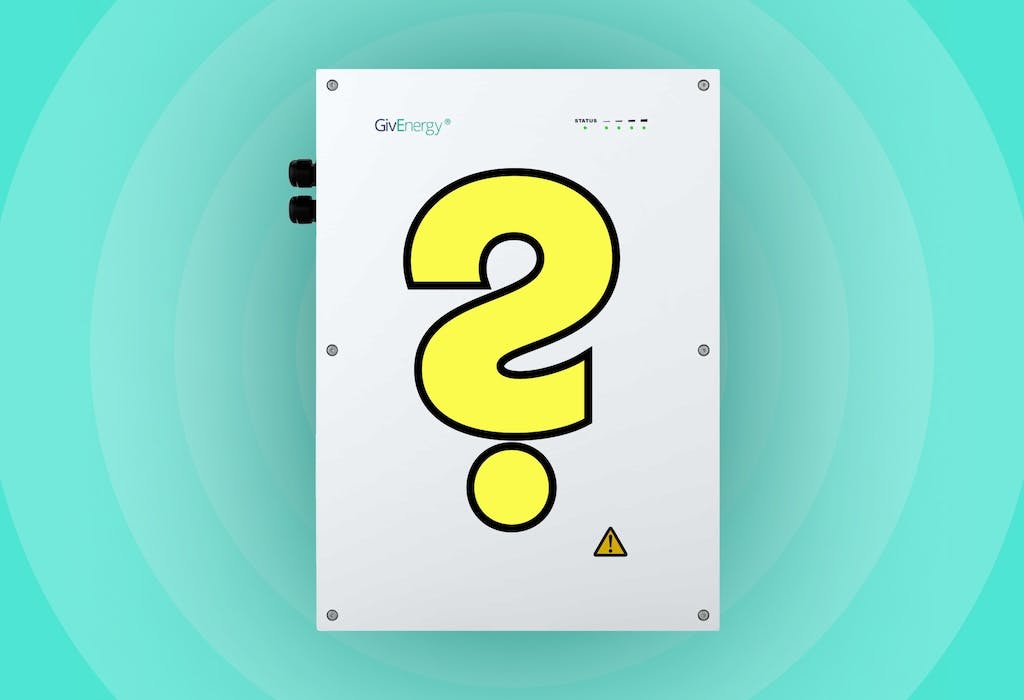
Solar batteries: at a glance
Solar battery storage is the ideal addition to a solar panel system.
It can hugely increase your savings from the electricity your panels generate, allow you to profit from buying and selling grid electricity, protect you from energy price rises and power cuts, and shrink your carbon footprint.
In this guide, we’ll run through everything you should know about solar battery storage, including how it works, how to pick the best type for your home, and how much it can save you.
If you would like to see the savings you could get from a solar & battery system, click the button below. Just answer a few quick questions, and we’ll provide an estimate.
What is a solar battery?
A solar battery is a storage device designed to hold onto the excess energy your solar panels generate throughout the day.
You can use this extra energy at times when the sun isn’t shining – such as evenings – or sell it to the grid through a solar export tariff.
Adding a solar battery to your system helps you to save even more money, both by enabling you to use a larger proportion of the electricity your panels produce, and by allowing you to take full advantage of the best export tariffs.
Without a battery, you’ll cut your electricity bills during the day, but leave yourself reliant on grid electricity after the sun goes down.

How does a solar battery work?
A solar battery, like any battery, stores chemical energy and converts it into electrical energy.
When daylight hits your rooftop, photons dislodge the electrons in your panels’ silicon atoms. This results in an electrical current, as electricity is simply the flow of electrons
If your household needs electricity straight away, these electrons will move into your inverter, which will convert them from direct current (DC) electricity into alternating current (AC) electricity that you can instantly use in your home.
If your property is receiving enough electricity at the time, the electrons will instead flow into your battery, possibly via an inverter, depending on whether your battery is AC-coupled or DC-coupled – but more on that later.
Once inside the battery, the electrons pass from the positive cathode to the negative anode, which charges the battery. They move with the help of an electrolyte, which can be a liquid, a gel, or a solid substance.
And when you need to use the electricity in the battery, it will discharge. This happens when the electrons flow in the other direction, from the negative anode back to the positive cathode.
This whole process of charging up a battery and then discharging a battery is called 'cycling' – more on that further down.
However, it's not healthy for a battery to ever be fully discharged, as it always needs a bit of power so it can stay operational. Therefore, every battery comes with a 'depth of discharge’ that tells you how much usable capacity it has.
How can a solar battery save you money?
A solar battery can save you money by allowing you to use more of the electricity your solar panels produce.
The average household will use 80% of its solar electricity with a battery if it runs it in a typical way, up from 50% without one.
You can save hundreds of pounds per year in this way.
And if you’re signed up to a time of use tariff, a battery could save you even more money on your electricity bills.
Without a battery, you’ll usually end up paying peak rates to get electricity from the grid during the morning and evening, when 20% of the average household’s daily usage happens – and when your panels aren’t typically generating as much electricity.
What’s more, the large majority of your solar electricity will be used during off-peak times, when you can’t save as much money.
Meanwhile, with a battery, you can save your solar electricity and use it during peak times.
Verified expertThe concept of ‘self-consumption’ is a very important one in solar, as it refers to the quantity of electricity generated by your panels that you’re actually using at home, as opposed to sending to the grid. Adding a battery to a solar panel system is a bit of a no-brainer, as it will dramatically increase your self-consumption and give you access to some of the best solar export tariffs.
Alfie Ireland
Head of Operations & Technical at Sunsave
Alfie has worked in green tech for over a decade. During his four years at OVO, he helped develop the world’s largest domestic vehicle-to-grid trial.
How much power can a solar battery provide each day?
A solar battery can provide as much electricity per day as it can store and safely discharge.
Whether it can power your whole home for a day depends on your electricity consumption and the battery’s size.
A 9.5kWh battery, for instance, can provide more than enough electricity for a standard day in the life of an average three-bedroom household – though this changes with the season.
Summer
During summer, a solar battery in the UK will usually have around half of its charge when the sun starts rising, as you can see above.
This 5.2 kilowatt-hour (kWh) battery – which is part of a 4.3 kilowatt-peak (kWp) solar panel system – will charge quickly under the sun’s light, moving to 100% soon after 6am.
With the household able to consume enough electricity straight from the panels during the morning and afternoon, the battery will stay fully charged until the evening period, when usage rises.
As the sun sets, the battery comes into its own, discharging 33% of its electricity (around 1.7kWh) so different members of the household can – for example – watch TV, use a games console, and play music on their speakers.
By the end of the day, the battery will still be 67% full, ready to power minimal overnight electricity usage and have plenty left over for the morning.
However, you shouldn’t take this average as a guarantee of how a solar battery would perform in your home. Your battery’s performance will depend on a number of factors, including its size, location, and depth of discharge, as well as the performance of your solar panels.
Winter
As the sun shines less in the winter and the days are shorter, your solar panels won’t generate as much electricity, which means less will be sent to your battery.
Overnight, your battery will typically have enough electricity to power a couple of hours of low usage, but by 1am, it’ll have depleted down to 20%, reaching its 80% depth of discharge limit.
Since the sun rises later, the battery won’t start filling up properly until after the peak electricity usage period, around 10am.
As electricity usage falls in the middle of the day, the battery will charge up quickly, hitting 100% around 2pm – but only staying at that level for a couple of hours.
When the peak period begins around 4pm, the battery will help the panels to power the house with free solar electricity, discharging quickly and falling below 50% by 7pm.
Despite the sun having long since disappeared from the sky, the battery is able to continue supplying the house with electricity until the day ends.
Again, this is just an average example, and how much electricity your battery provides your household at different times of the year will depend on many factors that are specific to your situation.
How can a battery earn you money?
A battery can earn you money by allowing you to take full advantage of time of use tariffs.
If you don’t have a battery, you can only export electricity when the sun is shining and your panels are producing. These times usually don’t coincide with peak periods, when exporting can earn you more money.
With a battery, you can store solar electricity throughout the day, then send it to the grid during peak times, when it’s most profitable for you.
And if you get a smart battery, you can maximise your revenues by importing electricity from the grid when it’s cheap, and exporting it back when it’s expensive.
Instead of sticking rigidly to the usage patterns we’ve described in the sections above, a smart battery can be intelligently programmed by your supplier to import and export at the most profitable times for you.
All you need to do is sign up to an import tariff and an export tariff that allow you to charge up on electricity at a lower rate, and export it at a higher rate.
For example, you could sign up for Intelligent Octopus Flux (IOF) with a qualifying battery, and you’ll automatically import electricity during the overnight off-peak time, and sell it back during the peak period, when you can make the most money.
You can also use Octopus Flux (OF), though it’s less effective. You’ll have to set the charge and discharge times yourself, and the battery won’t be able to use smart features like taking the next day’s weather into account when setting its charging and discharging pattern.
A smart battery won’t necessarily help you consume more of your solar electricity, however, so your self-consumption will probably stay around 50%. Instead, it’ll act as a pure buying-and-selling machine.
If you use a 5-6kWh smart battery in this way, you’ll import and export around 1,250kWh per year, completely separate from the solar electricity you’ll generate, use, and sell.
This will happen every day, with your battery charging up fully from the grid in the early hours of the morning, holding onto this charge during the day while your panels power your home and export excess electricity, then rapidly discharging it to the grid during peak hours.
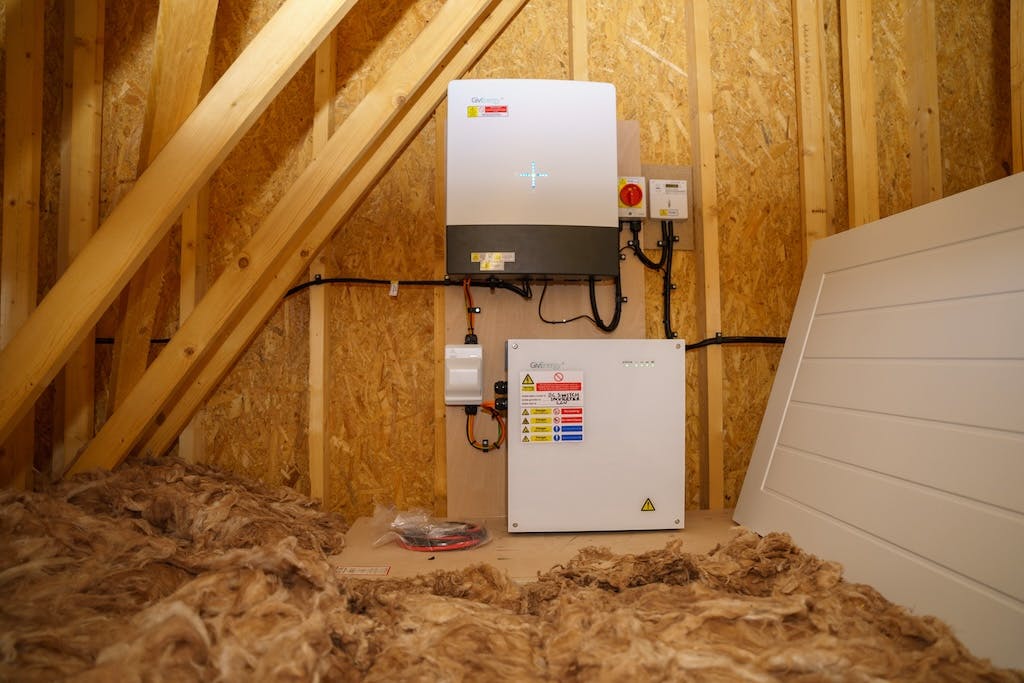
Summer with smart controls
When you add in smart controls and a time of use tariff, your battery’s behaviour will change significantly.
On any given day, the battery will automatically check the weather reports. If it sees the next day will be sunny, it’ll ignore the off-peak period and won’t import from the grid at all.
Instead, it’ll charge up on solar electricity, typically reaching 100% by 9-10am.
Your solar panels will continue producing electricity for the household and exporting the excess, then at 4pm, your battery will discharge until it’s ‘empty’ (i.e. reached its full depth of discharge), earning you the maximum amount possible.
Your household will use some of the electricity from your battery as well at this time, to reduce the amount of electricity you have to buy during the expensive peak period.
Winter with smart controls
If it’s winter, and your battery sees the weather tomorrow will be cloudy, it’ll charge up fully on grid electricity during the early hours of the morning, typically between 2am and 5am.
The battery will discharge a little throughout the day, both to the house and to the grid, and charge back up on the limited amount of daylight.
At 4pm, it’ll once again discharge all its electricity to the grid to produce maximum profits for you, while also sending some to the house.

The UK's first solar subscription
- No upfront cost
- Fixed monthly fee
- 20-year Sunsave Guarantee
The pros and cons of solar battery storage
There are many advantages – and some disadvantages – of getting solar battery storage, and you can find all the main ones below.
However, it’s unquestionably the only way to make the most of your solar panel system.
Is a solar battery worth it?
A solar battery is absolutely worth the investment.
It enables you to use more of the electricity your panels generate – which cuts your costs – and allows you to take advantage of the best export tariffs around, massively boosting your savings.
With a solar & battery system, you'll reduce your electricity bills by 103%, on average, which means across a year you actually earn more than you spend.

This might sound too good to be true, but it’s all because of the high performance of modern solar panels and storage batteries, as well as export income.
The panels will dramatically reduce the amount of electricity you buy from the grid, and you’ll also earn money by selling your unused electricity to the grid.
Having a solar & battery system lessens the effect of any electricity price rises – which will become more pressing in the coming years, as the electrification of the UK’s heating and transport sectors picks up pace.
Having a battery with solar panels will also you save 1.1 tonnes of CO2 per year, on average – or 31%. This is based on a database of 32 different solar & battery systems designed by Sunsave, located across England and Wales. Each system uses 430W panels and a 5.8kWh battery.
And it's a 31% reduction because the average UK household's carbon footprint is 3.5 tonnes per year. This figure is based on a government report that households account for 26% of the UK’s carbon footprint, the country’s latest emissions total of 384.2 million tonnes, and the fact that there are 28.2 million households across the nation at the last count.
What factors affect the payback period of a solar battery?
There are four key factors that’ll determine when you break even on your solar and battery system:
1. The size of your battery
If your battery is too small, it won't give you enough electricity when you need it, and you’ll be relying on the grid too much.
Likewise, a battery that’s too big will be a waste of money, and you won’t make enough use of it – though a larger battery is usually a good idea. To learn more, check out our guide to solar battery sizing.
2. The amount of electricity your solar panels can generate
If you’re not producing much electricity, your battery will be of pretty limited use. Your solar panels’ output is affected by factors including location, roof angle and direction, shading, and panel quality.
3. Your solar export tariff
This affects how quickly you can recoup the costs of exporting extra solar energy to the grid. Naturally, a higher tariff means more money for unused electricity.
To learn more, check out our guide to the best solar export tariffs available today.
4. The quality of your battery
Investing in a high-quality battery is crucial, as inferior batteries will degrade much quicker and may stop working before you’ve paid off the initial cost.
How much does a solar battery cost?
These prices include an inverter, the installation, and all associated costs – but it does assume that you’re getting the battery as part of a wider solar panel system.
If you get the battery added onto your system at a later date, it’ll cost much more, as you’ll have to pay the installation costs – like the labour, inverter, and scaffolding – all over again.
A 5kWh model added on its own will cost around £5,000 – more than double the cost of installing it with solar panels – while a 10kWh battery will set you back £7,000.
For more information, read our guide to how much solar batteries cost.
How much have solar battery costs fallen?
Solar battery costs have fallen by 97% since 1991, according to Our World In Data.
That means the same 5kWh lithium-ion battery that now costs you £2,000 to install at the same time as a solar panel system would’ve set you back £66,700 in 1991.
The price has plummeted as competition has grown, and as technological and operational developments have lowered manufacturing costs and led to the creation of lighter, smaller batteries.
With batteries getting increasingly popular and the need for global electricity storage only rising, this rate of progress shows no signs of slowing down.
In fact, every time the world’s total battery capacity doubles in size, the price per kWh falls by 19%, on average.
Lithium-ion battery costs, 1991-2018
Are there any grants for solar batteries?
There are grants available for solar batteries, but they’re generally targeted at the most deprived households, so most people won’t qualify.
You can get a solar battery through the Home Upgrade Grant, though it must be installed alongside solar panels – and you can only qualify if you don’t use a gas boiler as your home’s main heating system.
If you live in Wales, you may be eligible for a free solar & battery system through the Welsh government’s Warm Homes Programme.
This scheme is open to owners and private renters who live in an energy-inefficient property and have a low household income or someone who receives a qualifying benefit.
Solar batteries aren't currently a valid measure for recipients of the Warm Homes: Social Housing Fund (previously known as the Social Housing Decarbonisation Fund), but they will be in the near future.
This is because solar batteries weren't included in the latest version of the Standard Assessment Procedure (SAP), which the government uses to calculate the energy rating of homes – but they are expected to be in the upcoming version.
Only social housing providers can apply to this scheme, but you may still benefit from it if your landlord or local authority is successful in their application.
The government’s Britain-wide ECO4 scheme unfortunately doesn’t include batteries, as it’s primarily targeted at electric heating.
And the Home Energy Scotland Grant and Loan scheme's solar provision ended in June 2024. The Scottish government initiative previously offered a £1,250 grant and £4,750 interest-free loan for solar batteries.
You can still take advantage of the 0% VAT rate on solar panels and batteries though, which applies to all solar installations in England, Scotland, and Wales.
The government created this VAT exemption for energy-saving materials including solar panels and batteries in 2022, then expanded it to cover standalone solar batteries in 2024.
What size solar battery do you need?
Most homes in the UK use in the region of 3,500kWh of electricity per year – known as your Estimated Annual Consumption (EAC) – and though this number varies widely, let’s take it as a basis.
A three-bedroom household with an EAC of 3,500kWh and a 3.5kWp solar panel system on its roof will usually require around a 5kWh battery. In fact, a 5kWh battery is suitable for the vast majority of homes in the UK, and it's only when a property's EAC starts to exceed 5-6,000kWh that a larger battery becomes necessary.
To learn more, check out our guide to solar battery sizing.
If you’re interested in how much you could save with a solar & battery system, click the button below, enter a few details, and we’ll generate a quick estimate.
How to choose a solar battery
Choosing a solar battery is a complicated process that’s best left to a qualified installer.
However, it helps to have a decent grasp of the following elements, all of which will contribute to the final decision.
- Battery size
- Depth of discharge
- Charge and discharge rates
- AC-coupled vs DC-coupled
- Emergency Power Supply (EPS)
- Lifespan & warranty
- Battery controls
- Battery chemistry
1. Battery size
One of the most important parts of choosing the right battery is to select an appropriately sized machine for your solar panel system and home.
The size of a solar battery is measured in kWh instead of kW, because they store energy rather than creating it.
And as mentioned above, the average three-bedroom household with a 3.5kWp solar panel system should usually look for a 5-6kWh solar battery.
If there’s any possibility that you’ll increase your electricity consumption in the future, you should also ask whether your battery is stackable – which would allow you to easily add more modules at some point.
2. Depth of discharge
The depth of discharge (DoD) is the maximum percentage of a battery’s capacity you can use without risking damaging it.
Since batteries won’t let you discharge them beyond their DoD, you don’t need to worry about this happening while you’re using them – but considering this attribute is a vital part of the buying process.
After all, if you get a 5.2kWh battery with an 80% DoD, that means it has a useable capacity of 4.16kWh – which is 1.04kWh more than the same battery with a 60% DoD.
Thankfully, batteries with a DoD of 100% are becoming increasingly common.
Every battery also needs some electricity so it can operate and power its own Battery Management System, but this requirement isn’t factored into its DoD – which is why you can have batteries with a DoD of 100%.
3. Charge and discharge rates
A battery’s charge and discharge rates track how much electricity it can take in and send elsewhere, per hour.
These rates are measured in kilowatts (kW), rather than kWh like a battery’s storage capacity, and affect how many appliances in your home you can run with your battery alone.
For instance, if your battery’s discharge rate is 3kW, you’ll be able to power your lighting, TV, washing machine, two laptops, and a games console with no issue – but if it’s 5kW, you can also run a tumble dryer at the same time.
Your battery’s charge and discharge rates also have a major impact on your ability to maximise profits from your solar & battery system.
For instance, if your battery has a 3kW per hour charge rate and 15kWh capacity, it won’t be able to fully charge up during the three-hour off-peak period, when importing is cheapest.
It’ll reach 9kWh, and then either have to stop, or continue charging with more expensive grid electricity.
If the battery also has a discharge rate of 3kW, there’s no point in it getting any more electricity from the grid outside of the off-peak period, since it won’t be able to discharge more than 9kWh during the peak time anyway.
If you’re looking to increase your system’s discharge rate at any point, adding another battery won’t do it – but buying a second inverter will.
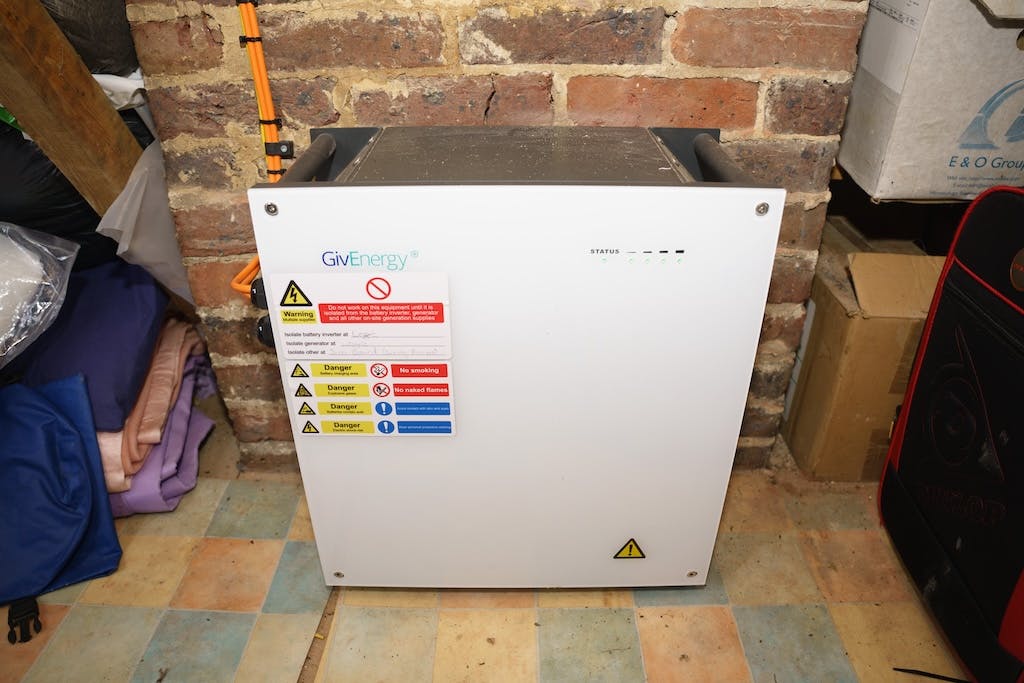
4. AC-coupled vs DC-coupled
Your battery can be connected to the inverter on the AC or DC side, meaning it either sits between your inverter and your house (AC side), or between your inverter and your panels (DC side).
AC-coupled batteries are more flexible, as they’ll work with any inverter or microinverter, and coexist more easily with EV chargers and solar diverters.
You’ll need DNO approval for an AC-coupled battery, as it has the ability to ignore the maximum limit of your inverter when it’s sending electricity to the grid.
DC-coupled systems are more efficient than AC-coupled versions, since they only have to carry out one conversion, and don’t require DNO approval, since their exports are limited by the inverter.
They’re also cheaper than AC-coupled batteries, as they only require one inverter, though this does need to be a hybrid inverter – that is, a device that has the capabilities of both a solar inverter and a battery inverter.
If you get a battery installed at the same time as your solar panels, it’ll likely be a DC-coupled model, whereas all retrofitted batteries are AC-coupled.
They’re both able to charge from and discharge to the grid, so either way, you may be able to access the top solar export tariffs.
5. Emergency Power Supply (EPS)
A solar & battery system will usually disconnect from the grid in the event of a power cut, to ensure there’s no risk of electricity lines being live while engineers are working on them.
But if your installer takes certain steps while setting up your battery, they can enable your battery to supply your home with electricity even when the grid goes down. However, Emergency Power Supply (EPS) isn't worth it in the vast majority of cases in the UK, with the average household experiencing just 0.4 outages per year, and losing electricity for just 35 minutes in total.
If you do want to go ahead with EPS, you just need to choose which level you want when the lights go off in your area. The higher the level, the more of your home you can power.
- Level 1: Just power sockets
- Level 2: Essential circuits (e.g. your lights and fridge)
- Level 3: Your whole home, but you’ll have to turn it on manually
- Level 4: Your whole home, and it turns on automatically
- Level 5: You can run your home off-grid for months, using whatever electricity your panels and battery provide
They’ll then install a relay that can physically disconnect your home from the grid in the event of a power cut.
After it’s all set up, all you’ll have to do is pick the minimum percentage of your battery you want to keep filled at all times, in case of a power cut. If you urgently require electricity at all times, for instance to keep medical equipment running, this level may need to be fairly high.
To learn more, check out our guide to EPS for solar.
Verified expertAs well as increasing your energy bill savings, some storage batteries also come with an Emergency Power Supply (EPS) feature, although you will have to pay extra to have this capability installed. However, most areas in the UK don’t have power cuts regularly enough to make EPS worth the additional cost.
Alfie Ireland
Head of Operations & Technical at Sunsave
Alfie has worked in green tech for over a decade. During his four years at OVO, he helped develop the world’s largest domestic vehicle-to-grid trial.
6. Lifespan & warranty
Solar batteries typically last 10-12 years at peak performance, but after this point they will start to decline considerably and need replacing.
Companies typically reflect this fact in their warranties – as shown by AlphaESS’s 10-year warranty on its SMILE-G3-S5 battery, or GivEnergy’s 12-year warranty on the Giv-Bat 5.2.
Some warranties also include the number of cycles a battery performs – that is, the amount of times it charges up and discharges. A cycle doesn’t have to be a full charge and a full discharge – even dropping down to 50% and filling up to 80% can count as a cycle.
The best batteries on the market are typically able to run through 6,000-10,000 total cycles over their lifespan, which is why Enphase’s IQ Battery 5P warranty is 15 years or 6,000 cycles long – whichever comes first.
There’s also an increasing number of companies offering battery warranties with unlimited cycles – for instance, GivEnergy’s bestselling Giv-Bat 9.5 comes with a 12-year warranty that has no cycle limit.
7. Battery controls
Battery controls allow you to charge your battery with grid electricity during cheap off-peak times, then discharge back to the grid during lucrative peak periods.
You can manually tell the battery to do this, or you can get a battery that allows third-party apps and services – such as your supplier – to manage it online and net you the highest profits possible.
8. Battery chemistry
Batteries are classified according to the materials they contain, which all produce slightly different chemical reactions that can affect a battery’s efficiency – that is, the percentage of energy a battery retains during the charging-discharging cycle and in storage.
The goal is to develop a battery that’s as close to 100% efficient as possible, and with lithium-ion batteries the industry has reached an impressive 96%.
Even within the field of lithium-ion batteries though, there are several different competing combinations of materials.
The most popular two are NMC – which uses nickel, manganese, and cobalt as the cathode material – and LFP, which uses lithium iron phosphate.
NMC batteries can charge faster than LFP models, but they’re also more expensive – because nickel and cobalt are becoming increasingly complicated to mine – and more prone to thermal runaway, which is a dangerous cycle of overheating.
On the other hand, LFP batteries are closing the charging speed gap, have a longer lifespan than NMC batteries, and are less likely to catch fire.
Both are excellent varieties of battery, and will last at least 10 years if used properly.
Do solar batteries require any maintenance?
Solar batteries generally need little to no maintenance, assuming you follow the manufacturer’s guidelines.
This can involve running a recommended number of daily cycles and keeping the system in certain conditions.
If you want to make sure you’re taking proper care of your battery and possibly extending its useful lifespan, you could consider booking an engineer once per year to assess the system’s health.
With a typical lifespan of 10-12 years though, solar batteries won’t perform properly for nearly as long as the 30-40 years solar panels last, even if they have no maintenance issues along the way.
Fortunately, every Sunsave Plus subscription is protected by the Sunsave Guarantee, which includes 24/7 monitoring and maintenance, free replacement parts (including a battery and inverter), and downtime cover. Your system will also be insured by Aviva against damage, fire and theft.
If you would like to see the savings you could get by signing up to Sunsave Plus, click the button below. Just answer a few quick questions, and we’ll provide an estimate.
What are the different types of solar battery?
There are five main types of solar battery, with multiple variations within each category.
Some of these batteries are cutting-edge, some are useful in certain situations, and others are simply outdated. Here are the different types:
- Lead-acid batteries
- Lithium-ion batteries
- Sodium-ion batteries
- Flow batteries
- Nickel-cadmium batteries
1. Lithium-ion batteries
Lithium-ion batteries are the best option on the market at the moment.
These machines, which use a lithium-salt electrolyte to carry electrons between the cathode and anode, have the highest average lifespan of any battery, at 10-12 years or 6,000-10,000 cycles.
Despite their longevity, they have limited maintenance needs if used properly.
They also come with a large capacity, plus they’re 96% efficient, charge and discharge more quickly than other types, and are smaller and lighter as well.
We supply Sunsave Plus customers with lithium iron phosphate (LFP) models – the newest, most cutting-edge version of lithium-ion batteries.
2. Sodium-ion batteries
Sodium-ion batteries are now being rolled out on the market, which could help solar batteries to continue and even propel their rapid growth in global popularity.
After all, sodium is much easier and cheaper to get your hands on than lithium. It’s abundant in nature, as shown by its prominence in a large variety of foods you eat – not least in salt.
That makes it an enticing alternative, as does the fact that it’s already reached a similar level of efficiency and capacity as lithium-ion batteries.
However, as yet, sodium-ion models can only perform around 3,000 cycles in their lifetime, meaning they’ll last less than half as much time as a typical lithium-ion machine.
Sodium-ion batteries represent one of the most exciting paths being explored by the industry, as solar batteries evolve to require fewer rare materials – but don’t expect to see them reach the capabilities of lithium-ion models any time soon.
3. Lead-acid batteries
Lead-acid batteries were created in 1859, making them the oldest type of rechargeable battery.
They use lead in the cathode and anode, which are placed in an electrolyte composed of watered-down sulphuric acid.
These batteries are still used all over the world, despite being less reliable, efficient, and long-lasting than lithium-ion batteries, on average.
Lead-acid models usually come to the end of their lifespan after three to seven years, and require regular maintenance to last even that long.
You’ll frequently need to add distilled water to the machine, while ensuring you don’t add too little or too much – as both can damage your battery.
They also typically charge and discharge more slowly than other varieties, which cuts into your ability to maximise your solar profits.
4. Flow batteries
Flow batteries use two chemical components dissolved in liquids as the anode and cathode, unlike most other types of batteries (where the anode and cathode are solid).
This machine, which like lead-acid batteries can trace its roots back to the 19th century, typically comes with a large capacity and long lifespan.
However, its low energy density means you’ll need to make space for a large, heavy piece of kit, and its materials – such as vanadium – make it far too expensive for most households.
Since flow batteries work better on a bigger scale, they’re usually more useful for commercial and industrial projects.
5. Nickel-cadmium batteries
Nickel-cadmium solar batteries are banned in the UK – as well as in the European Union – because cadmium is carcinogenic and highly toxic to humans.
No battery is allowed to contain more than 0.002% of cadmium, by weight, which makes creating nickel-cadmium solar batteries impossible.
The electrolyte used in these batteries is a strong alkaline that’s mainly composed of potassium hydroxide, a caustic compound which is also extremely dangerous.
Apart from these risks, nickel-cadmium batteries are decent. They’re capable of reaching high capacities, operating at a high energy density, and charging and discharging quickly.
However, they have a short lifespan that renders them a poor investment, especially as they come at a high price – or would, if they were legal in the UK.
How many UK households have solar batteries?
73% of UK households with solar panels also have solar batteries, according to certification body Flexi-Orb.
This equates to more than a million households, and positions the UK as one of the biggest supporters of solar batteries in Europe.
70% of Germany’s solar homes own batteries as well, while Italy and Austria sit far below on 45% and 30% respectively, according to SolarPower Europe.
This is remarkable, especially considering Italy started offering a ‘superbonus’ in 2020 that rewarded households that went solar with 110% of the cost of their installation in tax credits.
This has since been scrapped, but it still had a large effect on Italy's solar uptake.
How are solar batteries installed?
Solar batteries should be installed by a certified engineer, in a process that typically takes around half a day.
If they’re following the latest guidelines in the Publicly Available Specification (PAS) 63100, they’ll usually either set your battery up outside or in your garage.
Your loft space is a possibility though, as long as it offers enough space and a gable end wall where the battery can be mounted.
They’ll also install an inverter one to two metres away from your battery (if it’s not built-in), which they’ll connect to your battery, your fuse box, and the grid.
Your battery should be placed in a spacious area where air circulates freely, since a cramped space can cause your inverter to overheat and become less effective.
Most batteries sit on the floor, unless you're putting it in the loft or it's a wall-mounted model. In both these cases, it must be placed on a sturdy, load-bearing wall.
If your battery is installed outside, your engineer should put up a small canopy to protect it from hail and other falling objects, like branches – and if it’s visible to the public, they should place it behind a locked door to protect it from prying eyes.
The canopy, which can just be composed of two aluminium pins and an acrylic cover, usually costs between £150 and £300.
And even if you don’t have a suitable garage or outside space, there are other locations where it can be installed.
It can go in a hallway or spare room, as long as it’s well-ventilated enough to keep your inverter from overheating and doesn't block an escape route.
How big is a solar battery?
Solar batteries vary in size enormously, largely depending on which kind of battery you choose.
Lithium-ion batteries tend to be the most compact, as they have the best energy density – that is, how much electricity they can store in relation to their size.
They typically stand around 70cm high, 55cm wide, and 30cm deep.
Sodium-ion and nickel-cadmium batteries are designed in a similar way but have worse energy density ratings, so they’re usually slightly larger than lithium-ion models.
Lead-acid batteries are heavy, squat machines, while flow batteries are the largest of all the household solar batteries.
The newest domestic flow models are about two metres tall and weigh around 200kg – the same as 2.5 average Brits.
There are plenty of variations within the same type of battery, though. Even when you compare lithium-ion batteries with similar capacities, they range in height from 35cm to 1.7m, and from 0.3m² to 1.8m² in total area.
Can you install a battery without solar panels?
You can install a battery without solar panels, though it almost certainly won’t benefit you nearly as much.
If you’re on a time of use tariff that allows you to import electricity from the grid during off-peak periods and use it or send it back to the grid for peak prices, you can earn some money with a battery.
However, this generally won’t make you enough to break even on the initial cost of the battery.
And if you get your installer to take certain steps to create an Emergency Power Supply for you, you can also make sure your home has electricity when power cuts occur – though this is a costly process that’s usually entirely unnecessary in the UK.
The average household goes through 0.4 outages per year, and loses electricity for about 35 minutes overall, according to the latest Ofgem report.
It’s always better to use a battery with solar panels, as you can save hundreds of pounds per year, cut your carbon footprint, and lessen the impact of electricity price rises.
For more information, check out our guide to home battery storage without solar in the UK.
Can you add a solar battery to an existing solar panel system?
You can add a solar battery to an existing solar panel system.
However, it’ll usually cost more than having a battery installed at the same time as your panels.
For example, you’ll pay about £5,000 to add a 5kWh battery to an existing system – or just £2,000 if you get the entire solar & battery system in the same installation process.
You’ll have to pay for the labour, scaffolding, and inverter all over again if you get a battery at a later date, so it’s worth planning ahead.
This is the same principle you should use when deciding how many solar panels you need. Plan for the future, and you can lower your overall costs – and increase your total savings.
Next steps
A solar battery is a crucial addition to a solar panel system. It’s the best way to maximise your savings, protect yourself from power cuts and price rises, and reduce your carbon emissions.
The only drawbacks are a battery’s initial cost – which is typically £2,000 to £4,000 if you get it installed at the same time as solar panels, or £5,000 to £7,000 if you don’t – and its typical lifespan of 10-12 years, which well below your panels’ lifespan of 25-40 years.
Fortunately, you can wipe out both of these disadvantages with Sunsave Plus, which comes with no upfront cost and a free battery replacement.
If you’re wondering how much a solar & battery system could save you, just answer a few quick questions below and we’ll provide you with an estimate.
Solar batteries: FAQs
Related articles
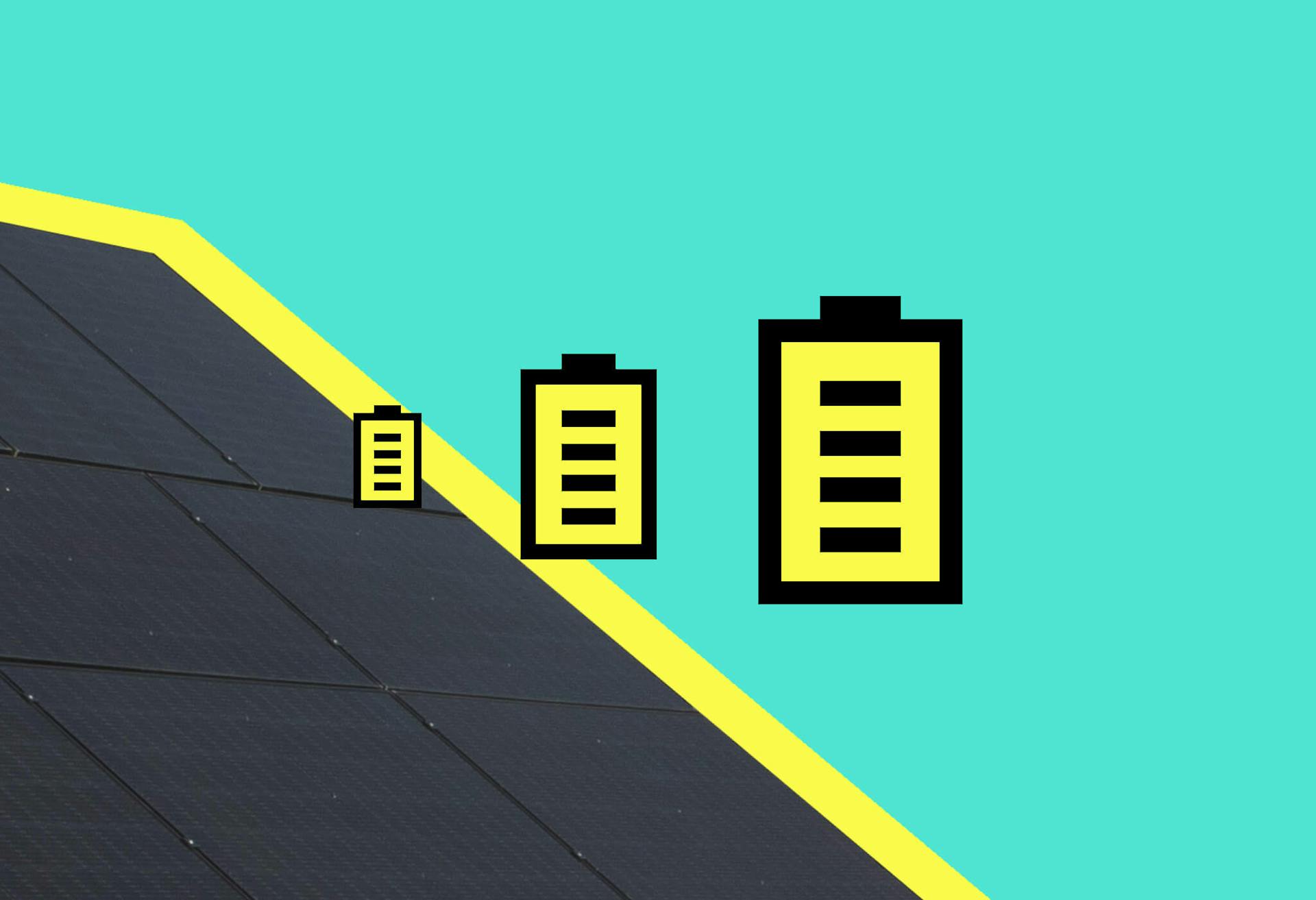
What size solar battery do I need?
Read full story
How long do solar batteries last?
Read full story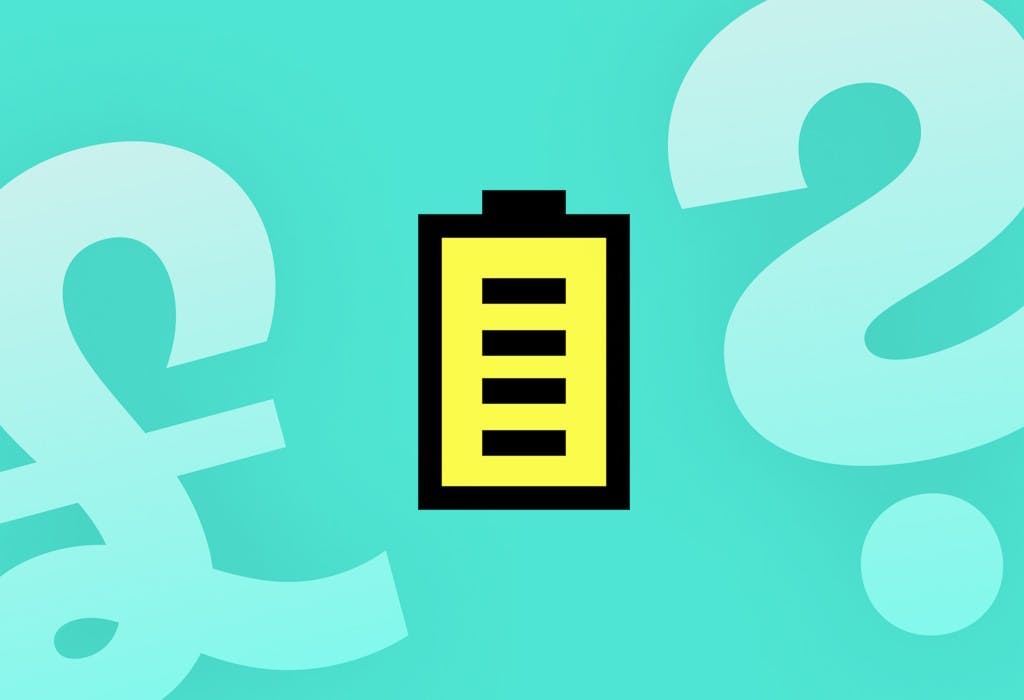
How much does a solar battery cost in the UK?
Read full story
Should you get a solar panel subscription?
Read full story
Written byJosh Jackman
Josh has written about the rapid rise of home solar for the past five years. His data-driven work has been featured in United Nations and World Health Organisation documents, as well as publications including The Eco Experts, Financial Times, The Independent, The Telegraph, The Times, and The Sun. Josh has also been interviewed as a renewables expert on BBC One’s Rip-Off Britain, ITV1’s Tonight show, and BBC Radio 4 and 5.
